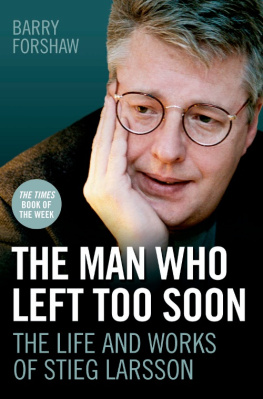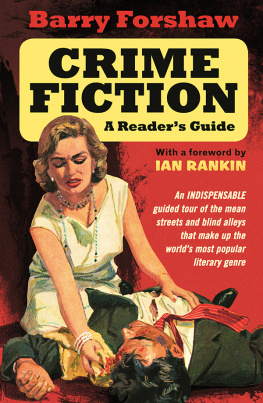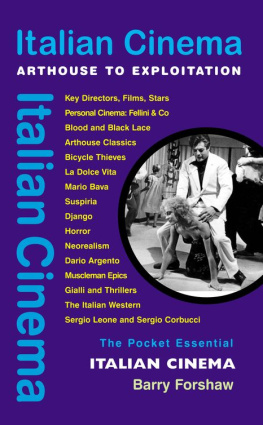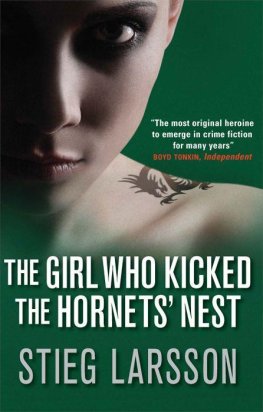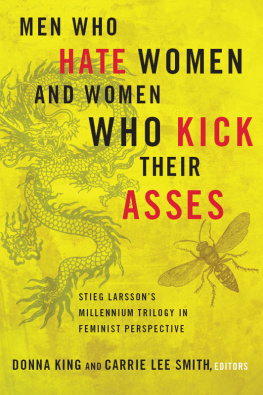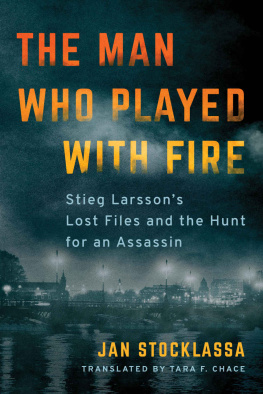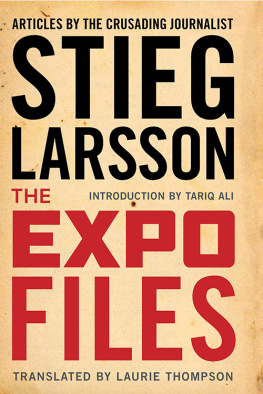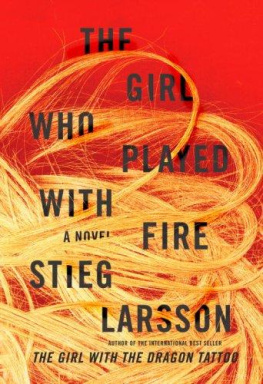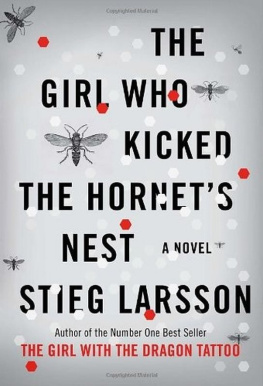
I m immensely grateful to all those who spoke to me for this book, in Sweden, the UK, the US and other points of the compass. Mark Campbell was a rock when I was putting together my British Crime Writing: an Encyclopaedia, and he has proved just as Gibraltar-like here (as indeed he has been in all my years of editing Crime Time), as was Tom Geddes, Scandinavian translator extraordinaire, particularly for this revised edition. An invaluable source was the Bloomsbury Square team of publishers MacLehose Press and Quercus: Lucy Ramsey, Nicci Pracca and Larssons UK publisher Christopher MacLehose, who gave me crucial help when I first entered the Larssonian world via interviews and articles for various UK newspapers and magazines.
I owe a particular debt to one of Larssons own favourite writers, Val McDermid, who was generous with her time. The Rap Sheets Ali Karim, Larsson aficionado extraordinaire, supplied much useful material, and Maxim Jakubowski who, apart from being the man who commissioned this book, availed me throughout of his usual crime fiction acumen. And Im particularly grateful to the authors, critics and journalists who gave of their time, along with Swedish friends and professionals (including publishers, agents and members of the Swedish Embassy in London, past and present with a special mention for Johan Theorin, providing me with invaluable Swedish scuttlebutt); they were in alphabetical order:
Karin Altenberg, Karin Alvtegen, Marcel Berlins, Ann Cleeves, N J Cooper, John Dugdale, Martin Edwards, R J Ellory, Dan Fesperman, Peter James, Rachel Johnson, Morag Joss, Camilla Lckberg, Mark Lawson, Dan Lucas, Julian Maynard-Smith, Steven Murray, Hkan Nesser, Kim Newman, Heather ODonoghue, Sofia Odberg, The Rap Sheet, Robert Ryan, Mark Sanderson, Yrsa Sigurdardttir, Joan Smith, Henry Sutton, Frank Tallis, Andrew Taylor, Boyd Tonkin, Dan Waddell, Minette Walters, Carl-Otto Werkelid, my copyeditor Rodney Burbeck and my inestimable editor John Wordsworth.
CONTENTS
A s the posthumous success of Stieg Larssons Millennium Trilogy seems to grow to ever-more unprecedented levels, with worldwide sales in the millions, it is an apposite time to celebrate the life and work of an intriguing, courageous and self-destructive man. Of course, extremely talented people often possess a certain carelessness with regard to their own health, for a variety of reasons. Leonard Bernstein certainly matched Stieg Larsson in terms of a prodigious nicotine intake, but preferred haute cuisine to the junk food that was another element in Stieg Larssons own reckless lifestyle.
Bernstein, however, believed he was one of the gods and that the health strictures which ordinary mortals were obliged to take note of simply didnt apply to him knowing that he was an immortal in terms of his music, he ill-advisedly applied this mindset to his much-abused body. With Stieg Larsson, who died in 2004 aged 50, the scenario was rather different, and the combination of what might be called a Protestant work ethic and a fierce desire to right the wrongs of the world were partly behind the cavalier approach to his own wellbeing. What counted was the work not maintaining the instrument that carried it out.
It goes without saying that Larssons early death is a crucial element in the mythic qualities that his life and work have come to possess. But it is the innovation and intelligence of the Millennium Trilogy (along with its trenchant and fierce social critiques, so much a part of Larssons own crusading personality) that are among the real reasons behind the all-conquering acclaim the books have engendered.
Just as Larsson cannily pays out chunks of information to his readers to create a total picture, it seemed to me appropriate to attempt something similar in this book. The approach I have taken is piecemeal, utilising a variety of elements Stiegs life, his influential journalistic career as a courageous fighter against extremist organisations, his relatives, his publishers, his translators, the successful movies being made from his books and the acrimonious dispute over his legacy. Ive been lucky enough to speak to most of the people concerned, but like virtually all readers of the novels, I never had a chance to meet the author, for whom the phrase taken too soon could have been coined.
Larsson aficionados will be aware that his biography is, to some extent, to be found in his books hence the concentration here on the three novels of his trilogy, with biographical data built into these sections rather than hived off into separate chapters, though his life is addressed separately. So at the centre of this study (to be read, of course, only after reading the novels themselves) is a thoroughgoing examination of the phenomenally successful novels in the trilogy: The Girl with the Dragon Tattoo, The Girl Who Played with Fire and The Girl Who Kicked the Hornets Nest, comprising one of the most striking and innovative trilogies in modern fiction. And for all their faults discussed here alongside their felicities the auguries are that the books will join the pantheon of the very finest popular literature, to be read for generations to come.
Barry Forshaw, London 2011s
CHAPTER 1
A t the prestigious Crime Writers Association Dagger awards in Londons Grosvenor House Hotel in October 2008, there was a no-show for one of the awards. An author had not appeared for a photo opportunity with the other nominees, and the clock was ticking. Where was Stieg Larsson? The Swedish author had been nominated for his astonishingly successful debut novel, The Girl with the Dragon Tattoo, and was the only author who could not be found for the photo call. It was a publicity opportunity that Stieg Larsson would never make. He had died before any of his three novels were published in his native Sweden, let alone seeing them become runaway bestsellers, or before they reached other shores in translation, going on to be a worldwide publishing phenomenon. And the fact that not everyone in the UKs top organisation for crime writers knew that the debut award was in fact a posthumous nomination was a measure of the unprecedented speed with which his star had risen. Whats more, having died suddenly before writing a will, he left behind a confused situation that has led to a bitter fracas over his considerable literary and financial legacy.
In fact, the Larsson story is even more remarkable: had he not become a bestselling crime writer, he would be remembered as something of a hero, a man who took on some dangerous neo-Nazi opponents, and whose premature death prompted much sinister speculation. How had he died? Was it simply as the official medical verdict had it a massive heart attack? Or did his enemies, who often told him that his days were numbered, have a hand in his demise?
Sales of The Girl with the Dragon Tattoo had reached the million mark in Sweden (under its original Swedish title Mn som hatar kvinnor Men who hate women) even before it was discovered by foreign publishers, and Larsson was already celebrated as a courageous, campaigning journalist, taking on far-Right groups. He also fought for the rights of battered women and could add impeccable feminist credentials to his impressive political rsum. He was, however, most celebrated as an authority on extremist organisations, and his battles with them often put him in physical danger something that seemed not to faze him. He was known in the UK to readers of the British-based international magazine Searchlight, which campaigns against racism and fascism, while in Sweden he became founder and editor of its Swedish equivalent,
Next page
